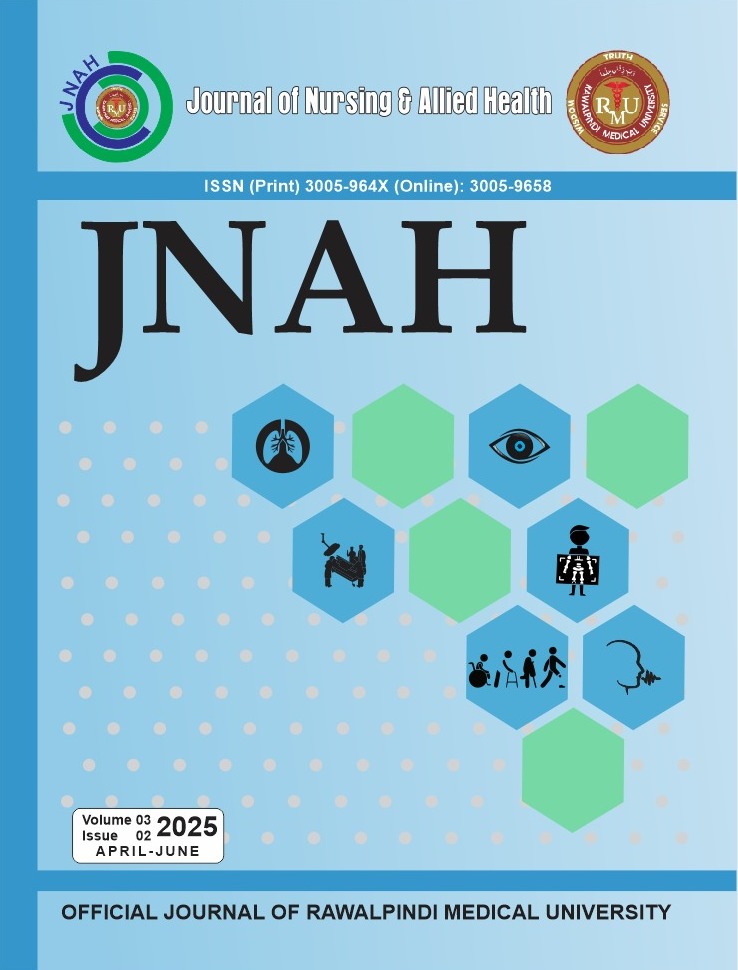Abstract
Objectives: The purpose of this study was to find out that how common lateral epicondylitis (LE) is among chefs. It also focused specifically on how age, gender, and working hours are associated with the prevalence of lateral epicondylitis.
Methodology: 200 chefs from different restaurants in Islamabad, Pakistan, were the sample for this analytical cross-sectional study. Cozen's test was used to diagnose LE, and the Patient-Rated Tennis Elbow Evaluation Questionnaire (PRTEEQ) assessed pain and impairment in participants who were having age between 25 and 54 and worked seven to ten hours a day. Using SPSS version 26, the chi-square test was used to analyze the data and find associations among the variables.
Results: According to the study, 68.5% of participants had positive Cozen's test results, showing a significant incidence of LE in the culinary industry. The age range of 30-34 had the highest frequency. Age and Cozen's test results showed a significant association (p = 0.04), as did working hours and Cozen's test results (p = 0.00). There was no significant association between gender and LE (p = 0.84). Younger chefs (25–29 years old) were more likely to have severe pain and disability; there was a substantial association between age and PRTEEQ levels (p = 0.00).
Conclusion: LE is a common work-related musculoskeletal disorder among chefs, especially in those with an age range of 30-34 years and having greater working hours. The study found that chefs of both sexes are equally vulnerable. These results emphasize the necessity of focused occupational health and ergonomic measures to lessen the effects of LE in this particular population.
References
Coombes BK, Bisset L, Vicenzino B. Management of lateral elbow tendinopathy: One size does not fit all. J Orthop Sports Phys Ther. 2015;45(11):938-949.
Karanasios S, Shetty P, Hussain F. Prevalence of work-related upper limb disorders in kitchen workers. Occup Med (Lond). 2018;68(5):342-347.
Shiri R, Viikari-Juntura E, Varonen H, Heliövaara M. Prevalence and determinants of lateral and medial epicondylitis: A population study. Am J Epidemiol. 2006;164(11):1065-1074.
Taylor SA, Hannafin JA. Evaluation and management of elbow tendinopathy. Sports health. 2012 Sep;4(5):384-93.
Haahr JP, Andersen JH. Prognostic factors in lateral epicondylitis: A randomized trial with one-year follow-up in 266 new cases treated with minimal occupational intervention or the usual approach in general practice. Rheumatology. 2003;42(10):1216-1225.
Walker-Bone K, Palmer KT, Reading I, Coggon D, Cooper C. Prevalence and impact of musculoskeletal disorders of the upper limb in the general population. Arthritis Rheum. 2004;51(4):642-651.
Cutts S, Gangoo S, Modi N, Pasapula C. Tennis elbow: A clinical review article. Journal of orthopaedics. 2020 Jan 1;17:203-7.
Ritz BR, Hough G, Aroian KJ. Occupational risk factors for lateral epicondylitis in a longitudinal study of industrial workers. Occup Environ Med. 2004;61(5):442-447.
Spahn G, Mückley T, Kahl E, Hofmann GO. Epidemiology of lateral epicondylitis in an employed population. Arthroscopy. 2013;29(6):897-904.
Palmer KT, Harris EC, Linaker C, Cooper C, Coggon D. Optimal grip strength for avoiding work-related upper limb disorders: A study of workers exposed to hand-transmitted vibration. Occup Environ Med. 2007;64(10):646-651.
Spahn G, Wollny J, Schiele R, Schmitz R, Mückley T, Kahl E, et al. Epidemiology and natural history of lateral epicondylitis in a working population. J Occup Health. 2015;57(1):9-14.
Descatha A, Leclerc A, Chastang JF, Roquelaure Y. Incidence of ulnar nerve entrapment at the elbow in repetitive work. Scand J Work Environ Health. 2004;30(3):234-240.
Lucado AM, Harper MR, Heilbronner K, Lutz NR, Maloney ME. Lateral epicondylitis in the restaurant industry: A study of chefs. Am J Ind Med. 2018;61(10):832-839.
van Rijn RM, Huisstede BM, Koes BW, Burdorf A. Associations between work-related factors and specific disorders at the elbow: A systematic literature review. Rheumatology (Oxford). 2009;48(5):528-536.
Badarinath S, Sridhar MS, Prasad PV. Role of ergonomics in the prevention and management of lateral epicondylitis. Indian J Orthop. 2012;46(3):310-317.
Esquirol Y, Perret B, Ruidavets JB, Marquie JC, Dienne E, Niezborala M, Ferrieres J. Shift work and cardiovascular risk factors: new knowledge from the past decade. Archives of cardiovascular diseases. 2011 Dec 1;104(12):636-68.
Smedley J, Harris EC, Cox V, Straughan C, Clarke K, Evans O, et al. Incidence and risk factors for work-related upper limb disorders: A four-year prospective study of 1200 newly employed workers. Occup Environ Med. 2003;60(11):874-881.
Rompe JD, Overend TJ, MacDermid JC. Validation of the patient-rated tennis elbow evaluation questionnaire. Journal of Hand Therapy. 2007 Jan 1;20(1):3-11.
Karanasios S, Korakakis V, Moutzouri M, Drakonaki E, Koci K, Pantazopoulou V, Tsepis E, Gioftsos G. Diagnostic accuracy of examination tests for lateral elbow tendinopathy (LET)–A systematic review. Journal of Hand Therapy. 2022 Oct 1;35(4):541-51.
Walker-Bone K, Cooper C. Hard work never hurt anyone: or did it? A review of occupational associations with soft tissue musculoskeletal disorders of the neck and upper limb. Ann Rheum Dis. 2005;64(8):1391-1396.
Shiri R, Varonen H, Heliövaara M, Viikari-Juntura E. Hand dominance in upper extremity musculoskeletal disorders. J Rheumatol. 2007;34(1):107-110.World Health Organization. Facts about high blood pressure [Internet].

This work is licensed under a Creative Commons Attribution-ShareAlike 4.0 International License.
Copyright (c) 2025 Journal of Nursing and Allied Health


